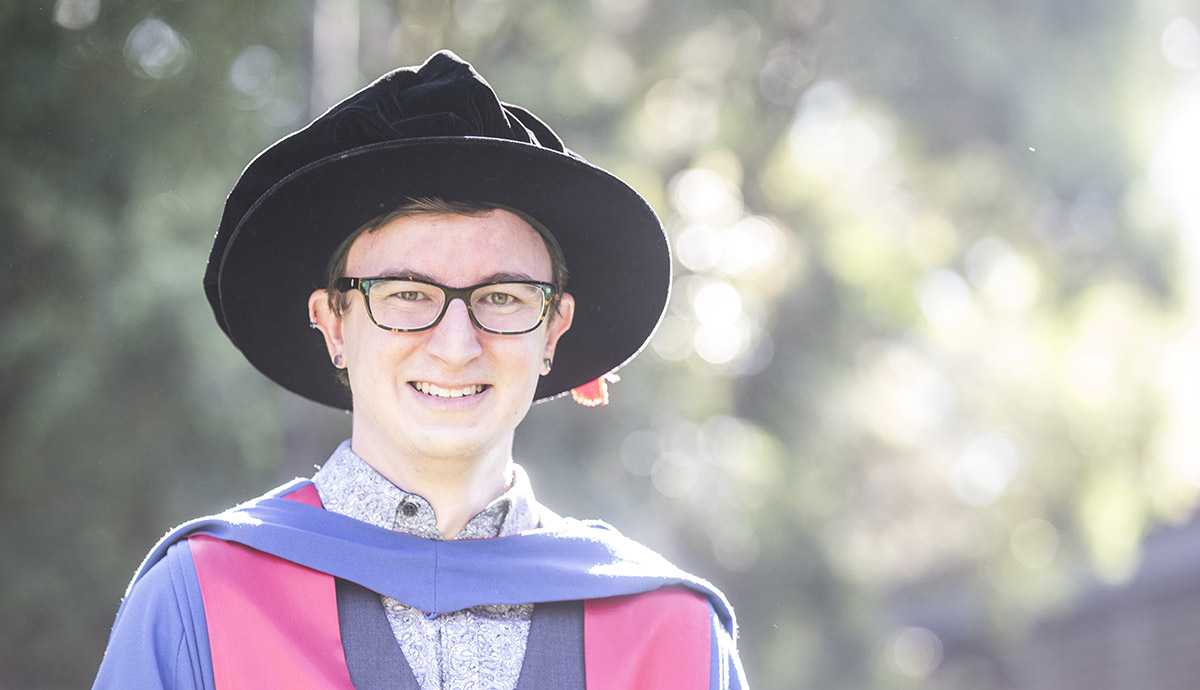April 20, 2017
There’s something queer about Disney villains
PhD student Dion McLeod analysed animated feature films in his thesis
Dion McLeod has watched the Disney animated feature Frozen 103 times – and the clip of the film’s hit song Let It Go another 100 or so times. He’s also watched Sleeping Beauty, Aladdin, The Little Mermaid, Tangled, Peter Pan, Beauty and the Beast and The Emperor’s New Groove between 30 and 40 times each.
While he did enjoy watching the films, the multiple viewings were done in the name of research for his PhD, which examines “the villain as queer in animated Disney films”. He was awarded his PhD from the Faculty of Law, Humanities and the Arts in a graduation celebration at the University of Wollongong today (Thursday 20 April).
The idea for his study grew out of an English course on children’s literature Dion took while studying for his Bachelor of Arts. After writing an essay on positive portrayals of homosexuality in children’s and young adult texts, he became interested in writing about the less positive (and far more common) way gay males were portrayed in popular culture.
“I started looking towards Disney and in my honours thesis I argued there were seven villains, all male villains, who were represented queerly. By the end of the year I realised it was much bigger than that. I thought, I have to write about this for a PhD. It's really fun and it's a really important topic that needs to be covered,” Dion said.
Finding enough queer villains to write about was never a problem. The more Disney animations he considered, the more villains he found that could be read as queer. And it’s not a new phenomenon either; the evil stepmother in the 1937 Disney film Snow White and the Seven Dwarfs fits the queer stereotype as much as more recent villains.
“In fact, every Disney villain was coded queerly,” Dion said. “My thesis looks specifically at full-length animated films where you have a villain that drives the plot, because I had to narrow it down somehow. So I didn’t look at Disney Pixar films and I didn't look at films like Fantasia that are made up of multiple segments, or Bedknobs and Broomsticks, which has got some live action.
“That brought it down to 34 films and in every one the villain – both male and female – is queered using queer stereotypes.
“In my thesis I looked specifically at the villains from eight films: Maleficent from Sleeping Beauty; Jafar from Aladdin; Ursula from The Little Mermaid – and Ursula is an interesting one because that was actually based on a real-life drag queen by the name of Divine; Mother Gothel in Tangled; Captain Hook in Peter Pan; Gaston from Beauty and the Beast; Yzma from The Emperor’s New Groove; and the final film I looked at was Frozen and I made an argument that Elsa can be read queerly there.”
Dion said the fact that villains are represented queerly is not necessarily a bad thing by itself, although “it's problematic if you've got queerness and villainy being put side by side”.
“The big problem is that at the end of every single film the villains are either killed off or they're jailed or they're just removed from the film altogether,” he said. “My overall argument is that Disney films perpetuate an idea known as heterosexism by first aligning the villains with queerness and then eliminating them from the narrative at the end of the film.
It’s important to analyse films in this way, Dion said, because people often absorb ideas and values from them without realising it. The fact Disney films are aimed primarily at children, makes it even more problematic that gay men are presented as prissy, effeminate schemers and lesbians as evil and butch.
“We often don't realise how problematic it can be when we rely on these old Hollywood stereotypes. They need to have a villain who looks different from the hero so that as a viewer we immediately know who we’re meant to like and who we're not meant to like. But it becomes a problem when the hero is always very masculine and the heroine is always very feminine, so the male villain becomes feminised or the female villain becomes masculinised.
“Children watch them and begin to unconsciously learn social norms. We learn from a young age that the prince needs to marry the princess and that's how you get a happy ending. So to have a queer character who's coded queer ... it raises the risk of children ingraining these ideas to do with queerness and seeing it in a negative light.
“And historically, particularly with Disney films, we haven't had any positive queer representation. And this goes beyond Disney to all sorts of media - look at films like The Grinch with the character of the Grinch or the classic Roald Dahl film Matilda where you've got The Trunchbull. This idea of queer villainy exists across the board.
“Elsa from Frozen can be read as a positive queer character, and the song Let It Go can be and has been read by queer audiences as a coming out anthem for Elsa. But Disney have yet to have an out gay character in an animated film. Hopefully in the next decade as the queer movement pushes forward we will get to see some more positive changes.”
